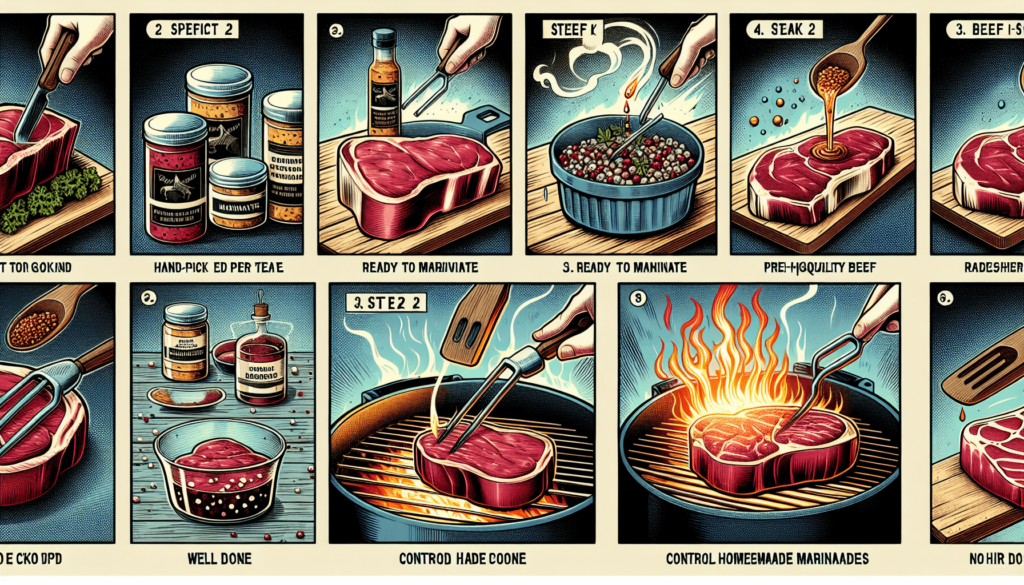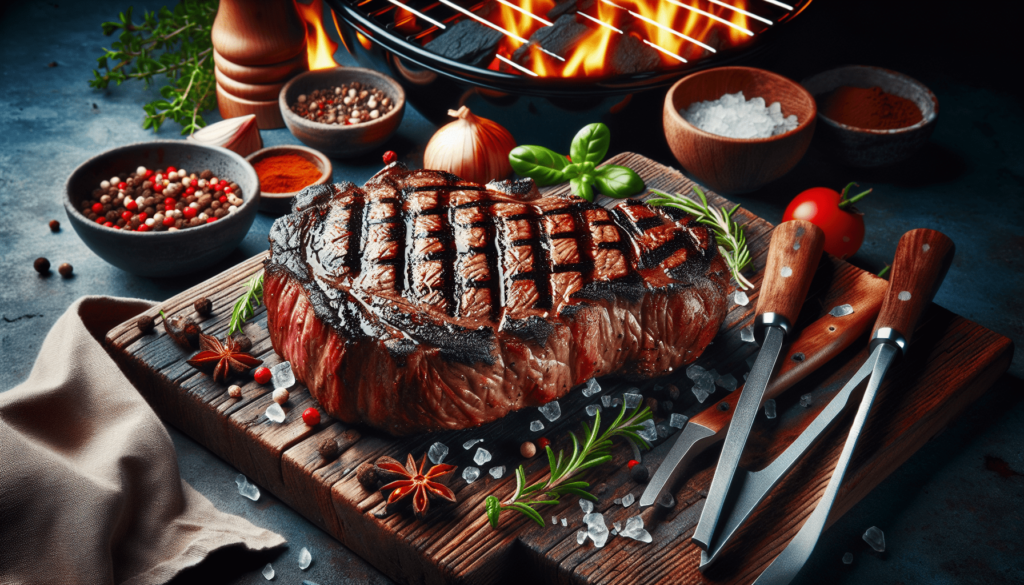When it comes to grilling the perfect steak, many factors come into play – the type of meat, the thickness, the marinade, and the cooking time. But amidst all these variables, there is one secret that can take your steak from good to exceptional every time. It’s all about the temperature. By understanding how different temperatures can affect the outcome of your steak, you’ll unlock the key to achieving that sizzling, juicy, and perfectly cooked steak that will have everyone asking for seconds. So, let’s uncover the secret to grilling the perfect steak every time.

Choosing the Right Steak
When it comes to grilling the perfect steak, choosing the right cut is crucial. Different cuts of steak have varying flavors, tenderness, and cooking times. It all boils down to personal preference, but there are a few popular cuts to consider. The ribeye, for instance, is known for its marbling and rich, juicy flavor. The tenderloin, on the other hand, is incredibly tender and lean. Other popular cuts include the New York strip, T-bone, and sirloin. Take the time to research and understand the characteristics and cooking methods for each cut, and choose the one that suits your taste buds best.
Determining the Thickness
The thickness of your steak plays a significant role in achieving a perfectly cooked piece of meat. Thicker steaks require more time on the grill to ensure they are cooked all the way through, without becoming overcooked or burnt on the outside. Thinner steaks, on the other hand, cook faster and require less grilling time. It’s essential to consider the thickness when determining the cooking method and the amount of time required to achieve your desired level of doneness. Thicker cuts may need to be seared and finished on indirect heat, while thinner cuts can be cooked using direct heat.
Inspecting the Marbling
Marbling refers to the small streaks of fat running through the muscle of the steak. While some may think fat is undesirable, marbling plays a crucial role in adding flavor and moisture to the meat during the grilling process. A well-marbled steak will be more tender and flavorful than a leaner cut. When selecting your steak, look for even distribution of fat throughout the meat. The marbling should be fine and not too thick, as excessive fat can lead to flare-ups on the grill. Inspecting the marbling ensures that you choose a steak that will yield the best grilling results.
Preparing the Steak
Before you even think about firing up the grill, it’s important to properly prepare your steak. One crucial step is to remove the steak from the fridge well in advance. Allowing it to rest at room temperature for about 30 minutes to an hour before grilling ensures that it cooks evenly. Seasoning the steak with salt is also a must. Salt not only enhances the natural flavors of the meat but also helps to tenderize it. Sprinkle a generous amount of salt on both sides of the steak and let it sit for a few minutes before grilling. Additionally, if you want to take the flavor to the next level, consider marinating the steak. A marinade can add depth and complexity to the meat, infusing it with delicious flavors. Choose a marinade that complements the cut of steak and let it soak for at least 30 minutes or overnight in the fridge for maximum flavor.

Preheating the Grill
To achieve the perfect steak, preheating your grill is crucial. A properly preheated grill ensures that your steak cooks evenly and develops a delicious char on the outside. Cleaning the grill grates is the first step. Remove any residue or leftover food from the previous grilling sessions. This prevents sticking and ensures easy flipping. Next, you need to decide whether to use a charcoal or gas grill. Each has its advantages and unique flavor profiles. Charcoal grills offer a smoky flavor while gas grills provide quick and easy cooking. Once you’ve decided, it’s time to fire up the grill and achieve the ideal temperature. For most steaks, a medium-high heat of around 450°F (230°C) works best. Allow the grill to preheat fully for at least 10-15 minutes before placing your steak on the grates.
Essential Grilling Techniques
Grilling a steak is more than just throwing it on the flames and flipping it a few times. To achieve the perfect steak, you need to understand and master a few grilling techniques. One of the first decisions you’ll make is whether to use direct or indirect heat. Direct heat is ideal for thinner cuts and searing the outside of the steak quickly. Indirect heat, on the other hand, is perfect for thicker cuts that require more time to cook through evenly. Creating a two-zone fire is another essential technique. By dividing your grill into two heat zones, you can sear the steak over high heat and then move it to the cooler zone to finish cooking without excessive charring. Finally, using a grill thermometer is crucial for achieving the desired level of doneness. Internal temperatures can vary, and an accurate thermometer ensures you don’t undercook or overcook your steak.
Mastering the Grill Marks
Grill marks not only add visual appeal to your steak but also provide a hint of smokiness and a caramelized flavor. To achieve those perfect grill marks, you need to position your steak correctly on the grill. Place the steak diagonally across the grill grates at a 45-degree angle. This creates those iconic crosshatch marks that make your steak look professionally grilled. Timing the flips is equally important. Resist the urge to constantly flip the steak. Allow it to cook undisturbed for a few minutes on one side before flipping it once to cook on the other side. Finally, to avoid the dreaded overcooking, be mindful of the cooking time. Use a timer or keep a close eye on the steak to ensure it reaches your desired level of doneness without becoming dry or tough.
Sealing in the Juices
Sealing in the juices is a crucial step in grilling the perfect steak. Searing the steak over high heat creates a flavorful crust while locking in the natural juices. Start by searing the steak for a couple of minutes on each side. This initial sear creates a beautiful caramelization and adds depth of flavor. After searing, it’s important to allow the steak to rest. Resting time allows the juices to redistribute throughout the meat, resulting in a moist and tender steak. To rest the steak, transfer it to a clean plate and loosely cover it with foil or butcher paper. Let it rest for about 5-10 minutes before slicing.
Checking for Doneness
Achieving the ideal level of doneness is vital to grilling the perfect steak. There are a few different methods you can use to check for doneness. The most accurate method is to use a meat thermometer. The internal temperature of the steak will determine its level of doneness. Rare steaks have an internal temperature of around 125°F (52°C), medium-rare is around 135°F (57°C), medium is around 145°F (63°C), and medium-well is around 155°F (68°C). Another method is the finger test, which involves pressing the steak with your finger and comparing the firmness to different areas of your hand. Lastly, be sure to consider the different levels of doneness and how they impact the texture and flavor of the steak.
Resting and Serving the Steak
After all the hard work of grilling the perfect steak, it’s essential to give it the proper resting time before slicing and serving. Resting the steak allows the muscle fibers to relax, resulting in a more tender and juicy piece of meat. Transfer the steak to a cutting board, tent it loosely with foil, and let it rest for at least 5 minutes. This resting period also helps to retain the juices, preventing them from spilling out when you cut into the steak. When it’s time to slice and plate, be sure to use a sharp knife to ensure clean cuts. Slice against the grain for maximum tenderness and arrange the steak on a serving platter. To take your steak to the next level, consider accompanying it with delicious sides such as grilled vegetables, crispy potatoes, or a fresh salad.
Dealing with Common Mistakes
Even the most experienced grill masters make mistakes from time to time. Knowing how to address common mistakes is essential to salvage a less-than-perfect steak. One common mistake is flare-ups. These occur when fat drips onto the flames, causing sudden bursts of high heat that can char the exterior of the steak. To avoid flare-ups, be sure to trim excess fat from the edges of the steak and keep a close eye on the grill. Another common mistake is dryness. To prevent dry steak, be mindful of the cooking time and the level of doneness you desire. Additionally, you can use a meat thermometer to ensure the steak is cooked to perfection. If you find that your steak is overcooked, there is still hope. You can rescue overcooked steak by slicing it thinly and using it in dishes like salads, tacos, or stir-fries where it can be reheated and remain flavorful.
Experimenting with Seasonings
While a perfectly cooked steak is delicious on its own, experimenting with seasonings can take it to a whole new level. Trying different rubs is an excellent way to add flavor and enhance the natural taste of the meat. From classic spice blends to homemade concoctions, the options are endless. Another way to elevate your steak is by infusing it with herbs and spices. Fresh herbs like rosemary, thyme, and cilantro can be chopped finely and rubbed onto the steak before grilling. You can also use whole spices like peppercorns or fennel seeds to create a crust on the steak. Don’t be afraid to explore unique flavor combinations by adding ingredients like soy sauce, balsamic vinegar, or even coffee to your marinades and rubs. Let your creativity shine and discover new tastes that will impress your guests and elevate your grilling game.
